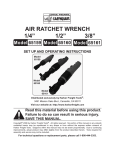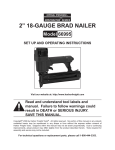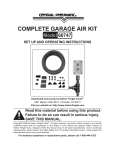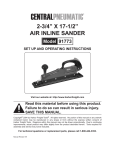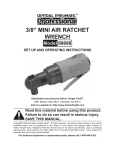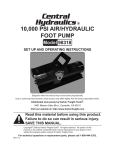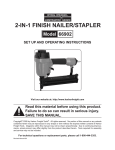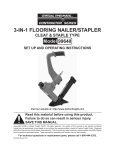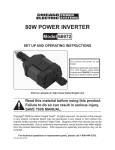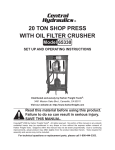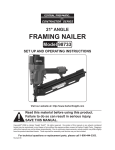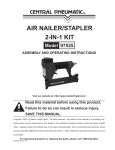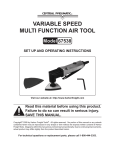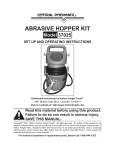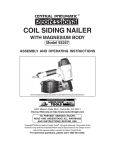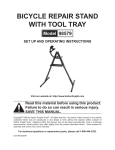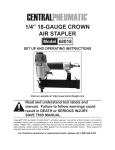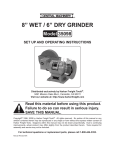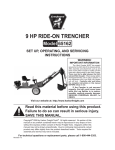Download Harbor Freight Tools 98917 User's Manual
Transcript
FRAMING NAILER 28 Degree 98917 Set up and Operating Instructions Visit our website at: http://www.harborfreight.com Read this material before using this product. Failure to do so can result in serious injury. Save this manual. Copyright© 2008 by Harbor Freight Tools®. All rights reserved. No portion of this manual or any artwork contained herein may be reproduced in any shape or form without the express written consent of Harbor Freight Tools. Diagrams within this manual may not be drawn proportionally. Due to continuing improvements, actual product may differ slightly from the product described herein. Tools required for assembly and service may not be included. For technical questions or replacement parts, please call 1-800-444-3353. Revised 09i; 09l Save This Manual NOTICE is used to address practices not related to personal injury. Keep this manual for the safety warnings and precautions, assembly, operating, inspection, maintenance and cleaning procedures. Write the product’s serial number in the back of the manual near the assembly diagram (or month and year of purchase if product has no number). Keep this manual and the receipt in a safe and dry place for future reference. Safety Alert Symbol and Signal Words In this manual, on the labeling, and all other information provided with this product: This is the safety alert symbol. It is used to alert you to potential personal injury hazards. Obey all safety messages that follow this symbol to avoid possible injury or death. DANGER indicates a hazardous situation which, if not avoided, will result in death or serious injury. WARNING indicates a hazardous situation which, if not avoided, could result in death or serious injury. CAUTION, without the safety alert symbol, is used to address practices not related to personal injury. IMPORTANT SAFETY INSTRUCTIONS Instructions Pertaining to a Risk of Fire, Electric Shock, or Injury to Persons General a. SKU 98917 To reduce the risks of electric shock, fire, and injury to persons, read all the instructions before using the tool. Work area CAUTION, used with the safety alert symbol, indicates a hazardous situation which, if not avoided, could result in minor or moderate injury. WARNING – When using tools, basic precautions should always be followed, including the following: a. Keep the work area clean and well lighted. Cluttered benches and dark areas increase the risks of electric shock, fire, and injury to persons. b. Do not operate the tool in explosive atmospheres, such as in the presence of flammable liquids, gases, or dust. The tool is able to create sparks resulting in the ignition of the dust or fumes. For technical questions, please call 1-800-444-3353. Page 2 c. Personal safety a. b. c. be used for the applicable conditions. Wear heavy-duty work gloves during use. Wear a full face shield if you are producing metal filings or wood chips. Keep bystanders, children, and visitors away while operating the tool. Distractions are able to result in the loss of control of the tool. Stay alert. Watch what you are doing and use common sense when operating the tool. Do not use the tool while tired or under the influence of drugs, alcohol, or medication. A moment of inattention while operating the tool increases the risk of injury to persons. Dress properly. Do not wear loose clothing or jewelry. Contain long hair. Keep hair, clothing, and gloves away from moving parts. Loose clothes, jewelry, or long hair increases the risk of injury to persons as a result of being caught in moving parts. Avoid unintentional starting. Be sure the Trigger (56) is off before connecting to the air supply. Do not carry the tool with your finger on the Trigger or connect the tool to the air supply with the Trigger on. d. Remove adjusting keys and wrenches before turning the tool on. A wrench or a key that is left attached to a rotating part of the tool increases the risk of personal injury. e. Do not overreach. Keep proper footing and balance at all times. Proper footing and balance enables better control of the tool in unexpected situations. f. SKU 98917 Use safety equipment. A dust mask, non-skid safety shoes and a hard hat must g. Always wear eye protection. Wear ANSI-approved safety goggles with side shields during use. h. Always wear hearing protection when using the tool. Prolonged exposure to high intensity noise is able to cause hearing loss. Tool use and care a. Avoid unintentional misfires. Although Nailer has a full sequential safety trip mechanism, do not point tool towards yourself or anyone whether it contains nails or not. b. Do not load fasteners when Nailer is connected to air hose. Always assume tool contains fasteners. Unintentional firing may occur. c. Fire nails into an appropriate work surface only. Do not attempt to fire nails into surfaces too hard to penetrate. Do not drive nails on top of other nails, or at too steep an angle. Nails can ricochet, causing personal injury. Never fire this tool into the air or point it toward yourself or another person. d. Hold tool away from head and body during use. Tool may kick back, causing injury. e. Do not fire nails too close to edge of workpiece. They may split the For technical questions, please call 1-800-444-3353. Page 3 workpiece and fly free, causing personal injury. f. Carry tool safely. Carry tool by handle. g. Use clamps or another practical way to secure and support the workpiece to a stable platform. Holding the work by hand or against the body is unstable and is able to lead to loss of control. h. i. Do not force the tool. Use correct tool for application. The correct tool will do the job better and safer at the rate for which the tool is designed. Disconnect the tool from the air source before making any adjustments, changing accessories, or storing the tool. Such preventive safety measures reduce the risk of starting the tool unintentionally. Turn off and detach the air supply and safely discharge any residual air pressure before leaving the work area. j. Store the tool when it is idle out of reach of children and other untrained persons. A tool is dangerous in the hands of untrained users. k. Maintain the tool with care. Keep tool clean. A properly maintained tool, reduces the risk of binding and is easier to control. l. Check for misalignment or binding of moving parts, breakage of parts, and any other condition that affects the tool’s operation. If damaged, have the tool serviced before using. Many accidents are caused by poorly maintained tools. There is a risk of bursting if the tool is damaged. m. Use only accessories that are identified by the manufacturer for the specific tool model. Use of an accessory not intended for use with the specific tool model, increases the risk of injury to persons. Service a. Tool service must be performed only by qualified repair personnel. b. When servicing a tool, use only identical replacement parts. Use only authorized parts. c. Use only the lubricants supplied with the tool or specified by the manufacturer. Air source a. Never connect to an air source that is capable of exceeding 120 PSI. Over pressurizing the tool may cause bursting, abnormal operation, breakage of the tool or serious injury to persons. Use only clean, dry, regulated compressed air at the rated pressure or within the rated pressure range as marked on the tool (60 to 120 PSI). Always verify prior to using the tool that the air source has been adjusted to the rated air pressure or within the rated air-pressure range. b. Never use oxygen, carbon dioxide, combustible gases or any bottled gas as an air source for the tool. Such gases are capable of explosion and serious injury to persons. Save these instructions. Rev 09l SKU 98917 For technical questions, please call 1-800-444-3353. Page 4 Symbols and Specific Safety Instructions Specific Safety Instructions 1. The warnings and precautions discussed in this manual cannot cover all possible conditions and situations that may occur. It must be understood by the operator that common sense and caution are factors which cannot be built into this product, but must be supplied by the operator. 2. WARNING: Some dust created by power sanding, sawing, grinding, drilling, and other construction activities, contains chemicals known [to the State of California] to cause cancer, birth defects or other reproductive harm. Some examples of these chemicals are: • Lead from lead-based paints • Crystalline silica from bricks and cement or other masonry products • Arsenic and chromium from chemically treated lumber Your risk from these exposures varies, depending on how often you do this type of work. To reduce your exposure to these chemicals: work in a well ventilated area, and work with approved safety equipment, such as those dust masks that are specially designed to filter out microscopic particles. (California Health & Safety Code § 25249.5, et seq.) 3. Take caution, as some woods contain preservatives such as copper chromium arsenate (CCA) which can be toxic. When nailing these materials, extra case should be taken to avoid inhalation and minimize skin contact. 4. WARNING: The brass components of this product contain lead, a chemical known to the State of California to cause birth defects (or other repro- Symbol Definitions Symbol no .../min Property or statement No-load speed Revolutions or reciprocation per minute PSI Pounds per square inch of pressure ft-lb Foot-pounds of torque BPM Blows per minute CFM Cubic Feet per Minute flow SCFM Cubic Feet per Minute flow at standard conditions NPT National pipe thread, tapered NPS National pipe thread, straight WARNING marking concerning Risk of Eye Injury. Wear ANSI-approved eye protection. WARNING marking concerning Risk of Hearing Loss. Wear hearing protection. WARNING marking concerning Risk of Respiratory Injury. Wear NIOSHapproved dust mask/respirator. WARNING marking concerning Risk of Explosion. SKU 98917 For technical questions, please call 1-800-444-3353. Page 5 ductive harm). (California Health & Safety code § 25249.5, et seq.) 5. Only use with accessories rated to handle forces exerted by tool during operation. Other accessories not designed for the forces generated may break and forcefully launch pieces. 6. Attach all accessories properly to the tool before connecting the air supply. A loose accessory may detach or break during operation. 7. Obey the manual for the air compressor used to power this tool. 8. Install in-line shutoff valve to allow immediate control over air supply in emergency, even if hose is ruptured. 9. Do not lay tool down until it has completely stopped. Moving parts can grab surface and lead to control loss. 10. The pressure setting must not exceed the job site regulations/restrictions. 11. The pressure setting on any Nailer should not exceed 90 PSI when working with workpieces that have a thickness of less than 1-3/4”. Vibration Precautions This tool vibrates during use. Repeated or long-term exposure to vibration may cause temporary or permanent physical injury, particularly to the hands, arms and shoulders. To reduce the risk of vibration-related injury: 1. use. Pregnant women or people who have impaired blood circulation to the hand, past hand injuries, nervous system disorders, diabetes, or Raynaud’s Disease should not use this tool. If you feel any medical or physical symptoms related to vibration (such as tingling, numbness, and white or blue fingers), seek medical advice as soon as possible. 2. Do not smoke during use. Nicotine reduces the blood supply to the hands and fingers, increasing the risk of vibration-related injury. 3. Wear suitable gloves to reduce the vibration effects on the user. 4. Use tools with the lowest vibration when there is a choice between different processes. 5. Include vibration-free periods each day of work. 6. Grip tool as lightly as possible (while still keeping safe control of it). Let the tool do the work. 7. To reduce vibration, maintain tool as explained in this manual. If abnormal vibration occurs, stop immediately. Save these instructions. Anyone using vibrating tools regularly or for an extended period should first be examined by a doctor and then have regular medical checkups to ensure medical problems are not being caused or worsened from SKU 98917 For technical questions, please call 1-800-444-3353. Page 6 Functional Description Air Supply To prevent explosion: Use only clean, dry, regulated, compressed air to power this tool. Do not use oxygen, carbon dioxide, combustible gases, or any other bottled gas as a power source for this tool. Specifications Working Air Pressure 70-120 PSI (Depending on nail length and wood density) Air Inlet 1/4” -18 NPT Magazine Capacity 90 Nails (Not Included) Magazine Angle 28° Air Consumption 8 CFM @ 60 PSI 10 CFM @ 100 PSI Safety Trigger Sequential Fastener Type Nail Type Paper-Collated Clip Head Nails Wire-Collated Full Head Nails 0.113” to 0.131” Shank Dia. 2-3/16” to 3-9/16” L / 28° Angle Initial Tool Set Up/ Assembly Read the entire Important Safety Information section at the beginning of this manual including all text under subheadings therein before set up or use of this product. Note: For additional information regarding the parts listed in the following pages, refer to the Assembly Diagram near the end of this manual. 1. Unpacking When unpacking, check to make sure that the item is intact and undamaged. If any parts are missing or broken, please call Harbor Freight Tools at the number shown throughout the manual as soon as possible. • This air tool may be shipped with a protective plug covering the air inlet. Remove this plug before set up. Incorporate an in-line oiler, shut-off valve, regulator with pressure gauge, and filter for best service, as shown in the diagram above. An in-line shutoff valve is an important safety device because it controls the air supply even if the air hose is ruptured. Note: If an automatic oiler system is not used, add a few drops of Pneumatic Tool Oil to the airline connection before operation. Add a few more drops after each hour of continual use. 2. Attach an air hose to the compressor’s air outlet. Connect the air hose to the air inlet of the tool. Other com- Rev 09l SKU 98917 For technical questions, please call 1-800-444-3353. Page 7 ponents, such as a connector and quick coupler, will make operation more efficient, but are not required. WARNING! To prevent serious injury from accidental operation: Do not install a female quick coupler on the tool. Such a coupler contains an air valve that will allow the air tool to retain pressure and operate accidentally after the air supply is disconnected. Note: Air flow, and therefore tool performance, can be hindered by undersized air supply components. 3. The air hose must be long enough to reach the work area with enough extra length to allow free movement while working. 4. Close the in-line safety valve between the compressor and the tool. 5. Turn on the air compressor according to the manufacturer’s directions and allow it to build up pressure until it cycles off. 6. Adjust the air compressor’s output regulator so that the air output is enough to properly power the tool, but the output will not exceed the tool’s maximum air pressure at any time. Adjust the pressure gradually, while checking the air output gauge to set the right pressure range. 7. Inspect the air connections for leaks. Repair any leaks found. 8. If the tool will not be used at this time, turn off and detach the air supply and safely discharge any residual air pressure. SKU 98917 Note: Residual air pressure should not be present after the tool is disconnected from the air supply. However, it is a good safety measure to attempt to discharge the tool in a safe fashion after disconnecting to ensure that the tool is disconnected and unpowered. To Attach An Air Connector: 1. Attach a 1/4” Connector (not included) to the Air Plug (83) prior to operation. 2. Wrap about 3” of pipe thread seal tape (not included) onto threads of the Connector before attaching it to the Air Plug. For technical questions, please call 1-800-444-3353. Page 8 Operating Instructions Read the entire Important Safety Information section at the beginning of this manual including all text under subheadings therein before set up or use of this product. Inspect tool before use, looking for damaged, loose, and missing parts. If any problems are found, do not use tool until repaired. TESTING THE FULL SEQUENTIAL SAFETY TRIP MECHANISM To prevent serious injury from accidental operation: Detach the air supply, safely discharge any residual air pressure in the tool, and release the throttle and/or turn the switch to its off position before performing any inspection, maintenance, or cleaning procedures. 3. Completely empty the Magazine (71) of Nails. 4. The Nailer should not fire if the Nose Safety Guide (42) is not depressed against the workpiece. 5. Make sure the Trigger (56) and Nose Safety Guide move freely, without sticking. 6. Connect the air supply to the tool at the Air Plug (83). Do not exceed the maximum 120 PSI. 7. Test the tool by depressing the Nose Safety Guide against the workpiece without pulling the Trigger. The tool must not cycle (fire). If it cycles (fires), stop immediately and have it repaired by a qualified service technician. 8. Hold the tool away or off the workpiece in a safe direction. The Nose Safety Guide should return to its original position. Squeeze the Trigger. The tool should not cycle (fire). If the tool cycles (fires), stop immediately and have it repaired by a qualified service technician. 9. Depress the Nose Safety Guide against the workpiece and squeeze the Trigger. The tool must cycle (fire) only once. Release the Trigger and squeeze it again. The tool must not cycle (fire). With the Trigger held, carefully lift the Nailer and press it against the workpiece again. The tool must not cycle (fire). If it fails to perform in the manner explained in bold, have it repaired by a qualified service technician. To prevent serious injury: Do not adjust or tamper with any control or component in a way not specifically explained within this manual. Improper adjustment can result in tool failure or other serious hazards. 1. WARNING! Even though the Nailer should be empty during this procedure, ALWAYS point the Nailer at a piece of scrap wood when testing. 2. Make sure the tool is disconnected from its air supply. SKU 98917 For technical questions, please call 1-800-444-3353. Rev 09l Page 9 Loading Nails: 1. 2. 3. Operating Nailer WARNING! Always wear ANSI- approved safety goggles when reloading or performing any other maintenance on Nailer. Other people in the work area must also wear ANSI-approved safety goggles. WARNING! Make sure Nailer is not attached to the air hose when loading tool. Note: This Nailer only uses 28° paper-collated clip head nails and wire collated full head nails. 4. Pull the Feeder Shoe (69) all the way to the rear until it latches. 5. Orient a strip of Nails (not included) with tips down and drop the Nails into the Magazine (71). 6. Slide the Nails forward in the Magazine. The Magazine will hold 90 Nails. 7. Pull Feeder Shoe backward and then press Lock (75) to allow Feeder Shoe to slide forward against the Nails. 1. Attach the Nailer to the air supply at the Air Plug (83). 2. Start your compressor and check the pressure, making sure you do not exceed the maximum 120 PSI. 3. Rotate the Exhaust Cover (4) so that the exhaust air blast will be directed away from the operator. 4. To fire, place the Nose Safety Guide (42) of the Nailer on the workpiece. The Nailer should not fire if the Nose is not depressed. 5. Once depressed, gently and briefly squeeze the Trigger (56) once; one Nail will be fired. 6. Do not press the Nose against the workpiece with extra force. Allow the tool to do the work. Always allow the tool to recoil off the work surface. 7. When finished using the Nailer, always disconnect the tool from its air supply. Empty the Magazine (71) completely of Nails. 8. Attempt to fire the Nailer into a piece of scrap wood to ensure it is disconnected and is incapable of firing any Nails. 9. Make sure to store the Nailer in a clean, dry, safe location out of reach of children. INSERT NAILS HERE Trigger (56) Magazine (71) Feeder Shoe (69) Nose Safety Guide (42) Rev 09l SKU 98917 For technical questions, please call 1-800-444-3353. Page 10 Clearing Jams WARNING! Anytime any maintenance or repairs are done (including clearing jams), wear ANSI-approved safety goggles and appropriate hearing protection. THEN: 1. Disconnect the Framing Nailer from its air supply. 2. Empty Magazine (71) completely. 3. Try to fire the Nailer into a piece of scrap wood or flooring to ensure that it is disconnected and incapable of firing any nails. 4. Always leave Magazine open during maintenance. The Magazine is spring-loaded, and may cause parts or a Nail to fly out of Nailer. 5. Occasionally, a nail may become jammed in firing mechanism of the Nailer, making the tool inoperable. 6. To remove a jammed nail, disconnect the tool from its air supply and empty the Magazine completely of nails. 7. 8. Attempt to fire Nailer into piece of scrap wood to ensure it is disconnected and incapable of firing. Use a pair of needle nose pliers to remove a jammed nail from back of Nose (30). If a jammed nail cannot be removed as described, it may be necessary to disassemble the Magazine as follows: CAUTION! If you are not clear about how to remove and re-assemble the Magazine to clear a jammed nail, have a qualified service technician perform this procedure. SKU 98917 9. Remove the Screw (35) from each side of the Magazine. (One on each Magazine side.) Remove the two Nuts (74). 10. Slide Magazine back, off of the Nose. 11. After clearing the jammed nail, reassemble Nailer Magazine in reverse order. 12. CAUTION! Make sure the Nose (30) moves freely. 13. Reload the Nailer with Nails. Then reconnect the air supply to tool. 14. Press Nose Safety Guide (42) against a piece of scrap wood and test fire Nailer several times while checking for operation. If the Nailer fails to perform properly, immediately discontinue use and have tool repaired by qualified service technician. 15. When finished working, disconnect the air supply. Remove the Nails. Then, store the Nailer in a clean, dry, safe location out of reach of children. Anytime any maintenance or repairs are done, FIRST: 1. Disconnect the Floor Nailer from its air supply. 2. Empty the Magazine (71) completely. 3. Try to fire the Nailer into a piece of scrap wood or flooring to ensure that it is disconnected and incapable of firing any nails. 4. Always leave Magazine open during maintenance. The Magazine is spring-loaded, and may cause parts or a Nail to fly out of Nailer. For technical questions, please call 1-800-444-3353. Page 11 User-Maintenance Instructions 4. Inspect the air supply screen located in the End Cap (82) before each use. Clean or replace as necessary. Dirt in the air supply is a major cause of pneumatic tool wear. Use a filter in the compressed air system for better performance and longer tool life. The filter must have adequate flow capacity for the specific application. 5. Clean the external parts of the Nailer with a clean cloth and mild detergent or non-flammable solvent. Then dry. 6. Store in a clean, dry and safe location out of reach of children. Procedures not specifically explained in this manual must be performed only by a qualified technician. To prevent serious injury from accidental operation: Turn off the tool, detach the air supply, safely discharge any residual air pressure in the tool, and release the Trigger before performing any inspection, maintenance, or cleaning procedures. To prevent serious injury from tool failure: Do not use damaged equipment. If abnormal noise, vibration, or leaking air occurs, have the problem corrected before further use. Cleaning, Maintenance, and Lubrication All maintenance, service or repairs not listed in this manual are only to be attempted by a qualified service technician. Record Product’s Serial Number Here: Note: If product has no serial number, record month and year of purchase instead. Note: Anytime inspection, maintenance and cleaning are done: Note: Some parts are listed and shown for illustration purposes only, and are not 1. Disconnect the Floor Nailer from available individually as replacement its air supply. parts. 2. Empty the Magazine (71) completely. 3. Try to fire the Nailer into a piece of scrap wood or flooring to ensure that it is disconnected and incapable of firing any nails/staples. SKU 98917 For technical questions, please call 1-800-444-3353. Page 12 Troubleshooting Follow all safety precautions whenever diagnosing or servicing the tool. Disconnect air supply before service. Problem Possible Solution 1. Tighten all screws on the cylinder cap. (See Assy. Diagram.) 2. Have a qualified service technician install a head valve piston set. Tool does not work. 1. Check all air connections for leaks. 2. Make sure to fully depress the nose of the workpiece when attempting to fire a nail. 3. Check for nail jams. Clear the jam if necessary. 4. Have a qualified service technician check out the tool. Sluggish operation. 1. Make sure the compressor regulator is set below 120 PSI. Make sure the compressor used produces sufficient C.F.M. to operate the Nailer. 2. Check all air connections for leaks. 3. Have a qualified service technician install a head valve piston set. Air leak near bottom of tool. 1. Tighten all screws. 2. Have a qualified service technician replace the bumper or head valve piston set. Poor return after firing tool. 1. Have a qualified service technician clean the interior of the tool and/ or replace the bumper or head valve piston set. Weak driving force. 1. Make sure the compressor regulator is set below 120 PSI. 2. Check all air connections for leaks. 3. Have a qualified service technician clean the interior of the tool and/or replace the bumper or head valve piston set. Poor feed. 1. Have a qualified service technician clean the interior of the tool and/or lubricate the magazine and install a new magazine spring. Tool jamming too often. 1. Have a qualified service technician clean the interior of the tool and/or lubricate the magazine and install a new magazine spring. Other problems. 1. Have a qualified service technician check out the tool. Air leak near top of tool. Follow all safety precautions whenever diagnosing or servicing the tool. Disconnect air supply before service. Rev 09l SKU 98917 For technical questions, please call 1-800-444-3353. Page 13 PARTS LIST Part 1 2 3 4 5 6 7 8A 9A 10 11 12 13 14 15 16 17 18 19 20 21 22 23 24 25 26 27 28 29 30 31 32 33 34 35 36 37 38 39 40 41 42 Description Screw (M5 x 20) Spring Washer (Ø 5) Bushing Exhaust Cover Seal Screw (M6 x 30) Spring Washer (Ø 6) Cylinder Cap O-Ring sealing Washer Valve Seat Spring O-Ring (57.5 x 2.6) O-Ring (72.4 x 3.5) Valve Screw (M6 x 8) Cylinder Seal Collar O-Ring (54.4 x 4) Piston Assembly Cylinder O-Ring (67 x 3) O-Ring (60.25 x s.5) Restrictive Plate O-Ring (97.5 x 3.5) Bumper A Bumper B Body O-Ring (62.3 x 1.8) Nose Spring Washer (Ø 8) Screw (M8 x 25) Spring Safe Bracket A Screw (M5 x 12) Bushing Safe Bracket B Washer Screw (M5 x 10) Rubber Cover Spring Pin Nose Safety Guide PARTS LIST Part 43 44 45 46 47 48A 49 50 51 52 53 54 55 56 57 58 59 60 61 62 63 64 65 66 67 68 69 70 71 72 73 74 75 76 77 78 79 80 81 82 83 Description O-Ring (20.3 x 2.5) O-Ring (20.3 x 1.5) Valve Set O-Ring (9.5 x 1.9) O-Ring (10.3 x 1.9) Trigger Valve Head O-Ring (12.8 x 1.9) Spring O-Ring (5.5 x 1.5) Trigger Valve Stem O-Ring (24.8 x 2) Trigger Valve Guide Spring Trigger Seal Pin Rail Washer (Ø 5) Nut (M4) Spring Washer (Ø 5) Coil Spring Assembly Pin Bushing Screw (M4 x 8) Block Spring Washer (Ø 4) Feeder Shoe Screw (M5 x 16) Magazine Screw (M4 x 16) Support Nut (M5) Lock Torsion Spring Bushing Nut (M4) Nut (M6) Soft Grip Sleeve O-Ring (65.4 x 2.5) End Cap Air Plug PLEASE READ THE FOLLOWING CAREFULLY The manufacturer and/or distributor has provided the parts list and assembly diagram in this manual as a reference tool only. Neither the manufacturer or distributor makes any representation or warranty of any kind to the buyer that he or she is qualified to make any repairs to the product, or that he or she is qualified to replace any parts of the product. In fact, the manufacturer and/or distributor expressly states that all repairs and parts replacements should be undertaken by certified and licensed technicians, and not by the buyer. The buyer assumes all risk and liability arising out of his or her repairs to the original product or replacement parts thereto, or arising out of his or her installation of replacement parts thereto. REV 09g SKU 98917 For technical questions, please call 1-800-444-3353. Page 14 ASSEMBLY DIAGRAM NOTE: Some parts are listed and show for illustration purposes only, and are not available individually as replacement parts. REV 09g SKU 98917 For technical questions, please call 1-800-444-3353. Page 15 Limited 1 Year warranty Harbor Freight Tools Co. makes every effort to assure that its products meet high quality and durability standards, and warrants to the original purchaser that this product is free from defects in materials and workmanship for the period of one year from the date of purchase (90 days if used by a professional contractor or if used as rental equipment). This warranty does not apply to damage due directly or indirectly, to misuse, abuse, negligence or accidents, repairs or alterations outside our facilities, normal wear and tear, or to lack of maintenance. We shall in no event be liable for death, injuries to persons or property, or for incidental, contingent, special or consequential damages arising from the use of our product. Some states do not allow the exclusion or limitation of incidental or consequential damages, so the above limitation of exclusion may not apply to you. This warranty is expressly in lieu of all other warranties, express or implied, including the warranties of merchantability and fitness. To take advantage of this warranty, the product or part must be returned to us with transportation charges prepaid. Proof of purchase date and an explanation of the complaint must accompany the merchandise. If our inspection verifies the defect, we will either repair or replace the product at our election or we may elect to refund the purchase price if we cannot readily and quickly provide you with a replacement. We will return repaired products at our expense, but if we determine there is no defect, or that the defect resulted from causes not within the scope of our warranty, then you must bear the cost of returning the product. This warranty gives you specific legal rights and you may also have other rights which vary from state to state. 3491 Mission Oaks Blvd. • PO Box 6009 • Camarillo, CA 93011 • (800) 444-3353 SKU 98917 For technical questions, please call 1-800-444-3353. Page 16
















